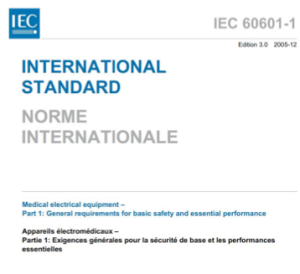What is the IEC 60601 Scope?
This blog explains the IEC 60601 scope to help you determine if and how IEC 60601-1 applies to your medical electrical equipment.
The first question to ask about IEC 60601 Scope
One of the first questions clients ask before a project starts is, “Does this medical electrical product fall under IEC 60601-1?” Another common question clients ask is whether IEC 60601-1 applies to battery-operated medical devices. To answer these questions, we must review and understand the scope (sub-clause 1.1) of IEC 60601-1 to determine if and how the IEC 60601-1 Standard applies to a medical electrical product.
The title of IEC 60601-1:2005 (3rd edition) is Medical electrical equipment – Part 1: General requirements for basic safety and essential performance. The IEC 60601-1 Standard itself states, “This…Standard applies to…MEDICAL ELECTRICAL EQUIPMENT and MEDICAL ELECTRICAL SYSTEMS…referred to as ME EQUIPMENT and ME SYSTEMS.”
*Note: ALL CAPITAL LETTERS identifies a defined term for the IEC 60601 series of standards within this blog. “IEC” is an acronym for the International Electrotechnical Commission. IEC is a non-profit, non-governmental international standards organization that prepares and publishes International Standards for all electrical, electronic, and related technologies.
All clause references in this blog are to both IEC 60601-1:2005 (3rd edition) and IEC 60601-1:2005 (3rd edition) + Amendment 1:2012, or the consolidated version IEC 60601-1:2012 (edition 3.1), but the actual text comes from edition 3.1.
Definitions
The ME EQUIPMENT definition (sub-clause 3.63) is:
“…equipment…
a) provided with not more than one connection to a particular SUPPLY MAINS, and
b) intended by its MANUFACTURER to be used:
1) in the diagnosis, treatment or monitoring of a PATIENT; or
2) for compensation or alleviation of disease, injury, or disability.”
and “…having an APPLIED PART or transferring energy to or from the PATIENT or detecting such energy transfer to or from the PATIENT….”
Note: The above definition aligns well with the description of medical electrical devices in the European Medical Device Regulation.
From the definition above, we know that a device can have up to one power cord, or be hard-wired to the building’s power by one power line, and/or be battery powered.
We also need to understand the term APPLIED PARTS (sub-clause 3.8): “Part of…ME EQUIPMENT…in NORMAL USE necessarily comes into physical contact with the PATIENT for…” the device “…to perform its function.” Classification of the different types of APPLIED PARTS and other classifications (there are eight different classification criteria in the IEC 60601 Standard) need to be completed early in the process of setting up a test plan for design verification to determine the applicable testing requirements, and to develop an appropriate test plan.
Examples within Scope of IEC 60601-1:2005
Examples of electrical medical products fitting the definition above are broad and include battery-operated thermometers, gamma imaging systems, endoscopic cameras, and infusion pumps. IEC 60601-1 may also apply to many ACCESSORIES (sub-clause 3.3) used with ME EQUIPMENT.
Examples not within Scope of IEC 60601-1:2005
The scope of IEC 60601-1 also identifies which devices are not included in the IEC 60601 series:
- “in vitro-diagnostic equipment…IEC 61010 series;
- implantable parts of active implantable(s) … ISO 14708 series…;
- medical gas pipeline systems…ISO 7396-1…”
IEC 60601 & ISO 13485
Design verification must confirm that design outputs (i.e., – product specifications) meet design inputs (e.g., – product must meet IEC 60601-1 requirements).
Many projects don’t identify all the applicable IEC 60601 standards. This could cause multiple nonconformances during an audit by the national regulatory body (i.e., FDA, EU Notified Body), or that you don’t obtain approval to sell and distribute your device from the national regulatory body.
A test plan, with multiple test protocols, is developed from the product specification. This test plan should identify all the requirements of the IEC 60601 series of standards, in addition to any other applicable standards and regulations that apply to the device before performing device testing.
Third-Party Testing
IEC testing can be performed by a third-party test house (i.e., – a safety certification agency, such as a BV, UL, CSA, TÜV SÜD), an independent test lab (i.e., Medical Equipment Compliance Association), or the manufacturer can conduct the testing if they have the proper equipment, trained personnel and a good understanding (i.e., – used the Standard on several projects, and successfully tested previous similar electrical medical device(s) by a third-party test lab, and been approved by a national regulatory body) of the Standard (s). However, for OSHA compliance in the USA, IEC testing should be performed by an Nationally Recognized Testing Laboratory (NRTL).
Design verification reports generated from the test process are either the applicable IEC 60601, and IEC 80601 series of standards test report forms or the manufacturer’s generated test reports.
The Author
 If your company needs help with IEC 60601-1 gap analysis, preparation of the risk management file for the third edition, or training on the Standard, please contact Leo Eisner (the “60601 Guy”). Leo also created a training webinar series on IEC 60601-1, 3rd edition.
If your company needs help with IEC 60601-1 gap analysis, preparation of the risk management file for the third edition, or training on the Standard, please contact Leo Eisner (the “60601 Guy”). Leo also created a training webinar series on IEC 60601-1, 3rd edition.
What is the IEC 60601 Scope? Read More »










